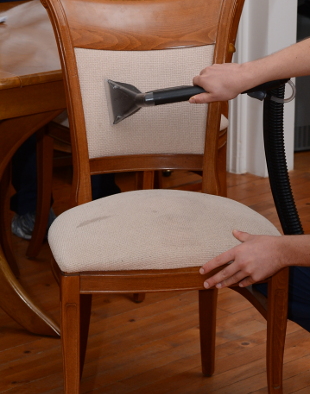How to Clean Upholstered Dining Chairs
Upholstered dining chairs add a touch of elegance and style to a dining room. Whether you have a quick breakfast or a dinner party with friends, the dining chairs not only have to be comfortable, but they have to be pristine clean.
Unfortunately, you can’t protect them from random spill accidents and kid’s sticky fingers, but you can prolong their lifespan if you learn how to clean and maintain them properly.

In this guide:
Before You Start Cleaning…
Here are some helpful practices from experience gained from years in professional cleaning for you to follow when cleaning upholstered dining chairs to avoid unwanted mistakes during the process:
- Check the manufacturer care label to find out what type of material is your dining chair made from and recommended cleaning methods and detergents for that upholstery.
- Test the cleaning solution on an inconspicuous area before applying it to the rest of the upholstery.
The methods below are suitable and efficient when it comes to removing fresh stains. However if you can’t clean them right away and allow the stains to dry and suck into the upholstery, it’s best to arrange a professional upholstery cleaning service, performed by expert technicians.
Now you are ready to get started, so just read on for several simple but efficient DIY methods for cleaning different types of padded dining chairs.
How to Clean Fabric Dining Chairs
Cleaning supplies you’ll need:
- vacuum cleaner
- upholstery and brush attachments
- crevice tool
- absorbent cloth
- clean towels
- liquid detergent
- rubbing alcohol
- white vinegar
[/one_half_last]
Be careful! Avoid using unsuitable cleaning products for fabric such as bleach, ammonia, abrasive cleaning products, alkalis. Learn more about what makes a detergent hazardous and how to protect yourself when using it.
Basic Cleaning

Regular basic cleaning removes any dirt, dust, crumbs and bacteria, and prevents the buildup of durable old stains. If you want to keep chair’s fabric looking fresh and bright, just make vacuuming part of your weekly cleaning schedule.
- To deep clean the fabric, brush it away with a soft upholstery brush.
- Pick up the accumulated dirt using the brush attachment of your vacuum cleaner. If the material is delicate, use the upholstery attachment instead.
- Clean the crevices and joints using the crevice tool.
Treating Stains
In case of any spills or stains, which are unavoidable, the faster you set to work, the better. Spillages and spots left to dry into the fabric will cause tough damage and be harder to remove.
Here’s what you can do to remove different kinds of stains from your fabric dining chairs:
Coffee, Tea, Fruit Juice, Wine
- Blot up as much excess liquid as you can, using a clean absorbent cloth. Do not press too firmly in order to prevent the stain spreading further.
- Apply a solution of equal parts of white vinegar and rubbing alcohol, using a clean rag.
- Press the stained area with another clean absorbent cloth.
- Entirely air-dry the chair before using it again.
Alcoholic Drinks
- Wipe off the area immediately using a clean towel.
- Moisten a clean cloth with rubbing alcohol and gently mop the stained area.
- Blot the spot with a mixture of 2 cups cold water and 2 teaspoons mild liquid detergent.
- Repeat step 2 if the stain remains.
- Wipe dry the area with a clean absorbent towel.
Grease Stains
- Scrape off the stain with a dull knife to remove any excess oil.
- Spray a homemade solution of 1 cup of water and ½ cup of white vinegar on the spot.
- Wipe off the vinegar-soaked area with a clean, white towel. It will take up the slackened stain along with the vinegar.
- Repeat the process if you still notice the stain.
- Let the chair fabric completely air-dry before using it.
How to Clean Leather Dining Chairs
Cleaning supplies you’ll need:
- microfiber cloth
- paper towels
- mild liquid soap
- household sponge
- baking soda/cornstarch
- leather conditioner
- brush vacuum attachment
- rubbing alcohol
Regular Maintenance
Maintenance is the key to keep your chairs perfectly clean all the time. If you take care of them regularly, they will always look good and, be sure, will last longer.
Follow this step-by-step guide to clean and care for your leather dining chairs with minimum effort:
Step 1: Vacuum and dust them at least once a week to prevent any grime and dirt to stack in the crevices and corners. For best results, use the soft brush vacuum attachment and a microfiber cloth.
Step 2: Give your padded chairs a regular basic cleaning even if they haven’t been a victim of stains and spillages. You can maintain leather with basic household products.
- Apply a solution of a few drops of mild liquid soap and warm distilled water, using a clean rag.
- Get another clean cloth, soak it in only distilled water and wipe down the leather.
- Rub dry the chair with a third clean rag.
Step 3: Condition the leather at least twice a year to prevent it from cracking and to restore its natural oils. Apply a small amount of a leather conditioner to a dry cloth and rub it into the clean leather using circular motions until it has a nice shine.
Removing Stains
The fundamental rule you have to follow when tackle stains on your leather dining chairs, is to avoid soaking with water because this encourages cracking.
Liquid Stains
- Blot out as much of the liquid as possible applying a clean cloth or paper towel to the stained area. Do not rub!
- Make a solution of mild liquid soap and lukewarm water. Stir the soap into the water to create a volume of suds.
- Apply only the foam to the stain, using a clean household sponge. Lightly wipe off the leather surface, do not scrub.
- Dry the area with a clean towel.
Oil & Grease Stains
- Wipe up the spill immediately with a dry cloth or paper towel. Try not to spread the stain, just press down the cloth against the leather surface.
- Cover the affected area with baking soda or cornstarch and let it sit for several hours or overnight.
- Brush the solution away using a brush with soft bristles. If the stain remains, repeat the cleaning process with more cornstarch.
- Thoroughly vacuum the area and apply a leather cream with a clean cloth.
Ink Stains
- Gently scrub the spot in a circular motion with a cotton ball moistened with rubbing alcohol.
- Once you have removed the ink, wipe down the leather with a damp cloth.
- Dry the surface using a clean rag or paper towel.
Tip for Upholstery Conservation
The upholstery and carpets act as a filter – they collect dirt and dust all the time. The accumulated grime causes fabrics to wear quickly. Apart from taking care of your pieces to prolong their life, you have to maintain your sofas and dining chairs on a regular basis as well.
Regular Vacuuming
Meticulously vacuuming the upholstery on your dining room chairs at least once a week (if you have kids or pets – even more often) will prevent any dust and crumbs from penetrating the fabric. It also helps stop allergens such as household dust mites from spreading.
In order to obtain the best results, you should use the upholstery attachment of your vacuum cleaner to be able to reach all the tight spots, crevices and folds. If you are a pet-owner, you may use a pet fur remover to get rid of all pet hair sticking to your upholstered dining chairs.
Avoid Direct Sunlight
The most important thing you should keep in mind is the relationship between light and damage to furniture surfaces. Any bright coloured fabric will fade if it is exposed to direct sunlight for a long period of time.
You can reduce the damage, even if you have conservatory dining area, using curtains and blinds. It is advisable to store furniture in a dark place when it is not in use.
Professional Cleaning
High-quality furniture is an investment, so your primary purpose is to keep it in a good shape for years to come. Regular maintenance is an essential part of the care for your furnishings, but sometimes it isn’t enough, especially for old, stubborn stains.
To prolong your dining chairs’ life, the experts at Go Cleaners London advise to have the upholstery professionally cleaned at least twice a year. Depending on the fabric, you can use pressurised hot water extraction or dry chem cleaning.